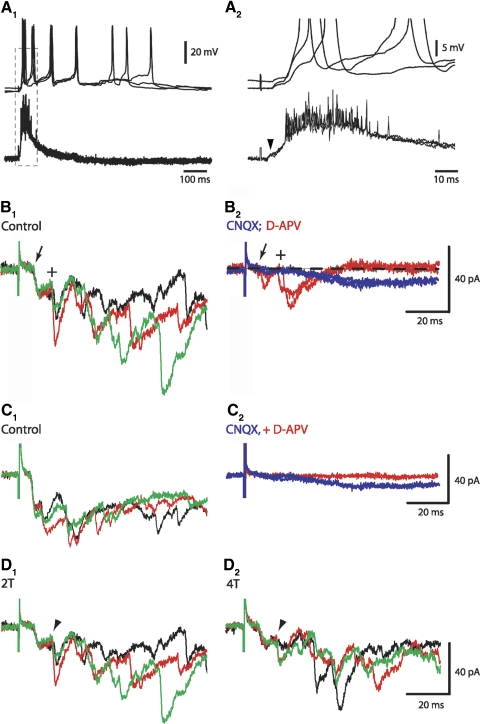Fig. 1.
Low-intensity stimulation of segmental afferents generated short-latency excitatory postsynaptic potentials/currents (EPSPs/EPSCs) in homeobox gene Hb9-expressing interneurons (Hb9 INs). Unless otherwise stated, evoked responses were generated by stimulating dorsal roots at the same segment as Hb9 INs and recordings were carried out at postnatal day 2 (P2) to P3. A1: L2 dorsal root (DR) stimulation (twofold the threshold [2T] at 300 μs) produced short-latency excitatory potentials in a L2 Hb9 IN (top trace) and in segmental motoneurons (bottom trace). Ventral root (VR) potentials were recorded using a high-pass filter of 0.1 Hz (quasi-DC recording). A small VR potential (arrowhead) was recorded before the onset of the large potential. Superimposed are traces of 3 successive potentials generated at 0.1 Hz stimuli. DR-evoked membrane depolarizations and firing in Hb9 INs lasted significantly longer than the excitation of motoneuron population. A2: expanded timescale of traces shown in the boxed portion in A1. Resting membrane potential: −55 to −60 mV. B1: in a different Hb9 IN, L2 DR stimuli at 0.1 Hz produced compound EPSCs with stable short-latency (6.2 ms, arrow) and long-latency (14.6 ms, +) dual-component EPSCs (control). Superimposed are 3 successive evoked synaptic events in the order of black, red, and green traces. B2: exposure to CNQX (10 μM, blue trace) blocked the dual-component EPSCs, suggesting that they were mediated via non-NMDA receptors. A small CNQX-resistant component (∼9 pA) was recorded after a long latency (>20 ms). EPSCs were partially recovered within 20 min of CNQX removal (not shown). Exposure to d-APV (20 μM, red trace) did not suppress the dual-component EPSCs but it completely blocked the longer-latency EPSCs. Unless otherwise stated, voltage-clamp recordings were carried out at a holding potential of −60 mV. Baseline is marked by the dashed line. C1: dual-component and polysynaptic EPSCs in L2 Hb9 IN. C2: exposure to CNQX suppressed the dual-component EPSCs and the CNQX-resistant component was suppressed by adding d-APV to the CNQX-containing solution. D1: evoked EPSCs in the same L2 Hb9 IN shown in B. D2: higher-intensity stimuli (4T) did not change significantly the amplitude of the short-latency component but it reduced the amplitude of the 2nd component EPSC (arrowhead).

